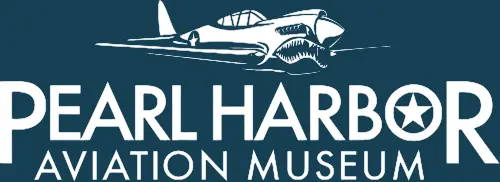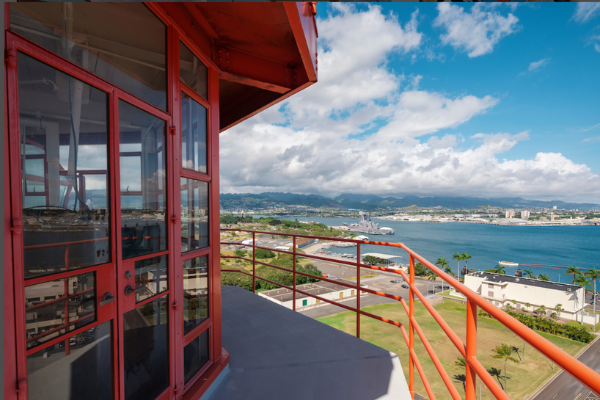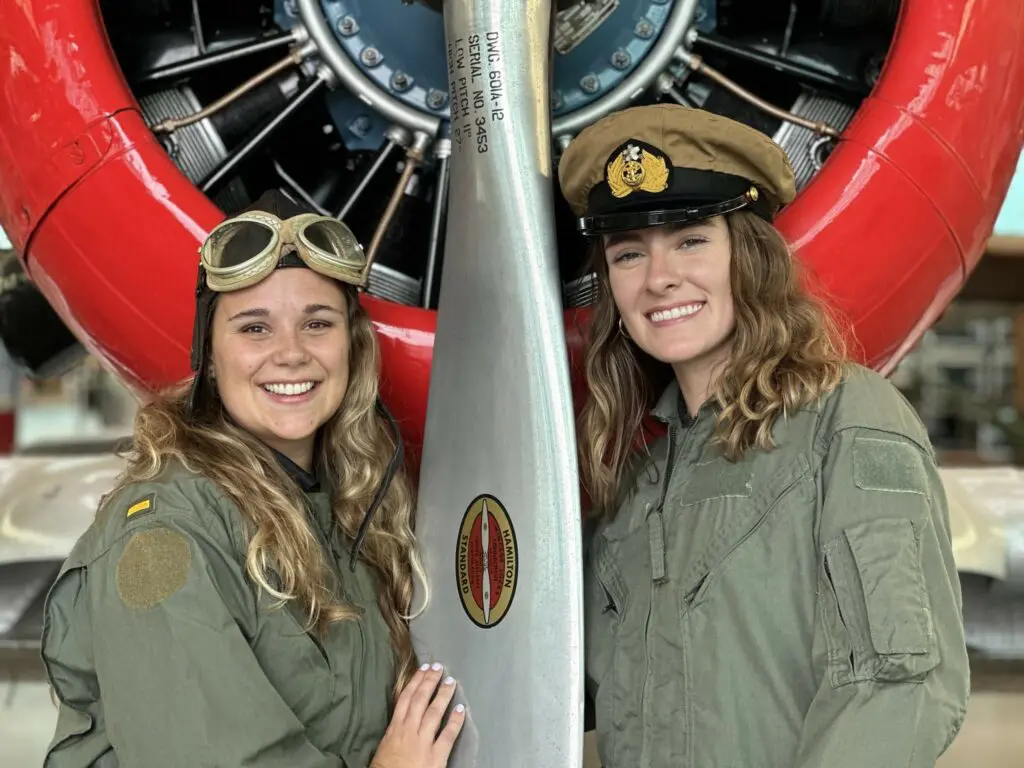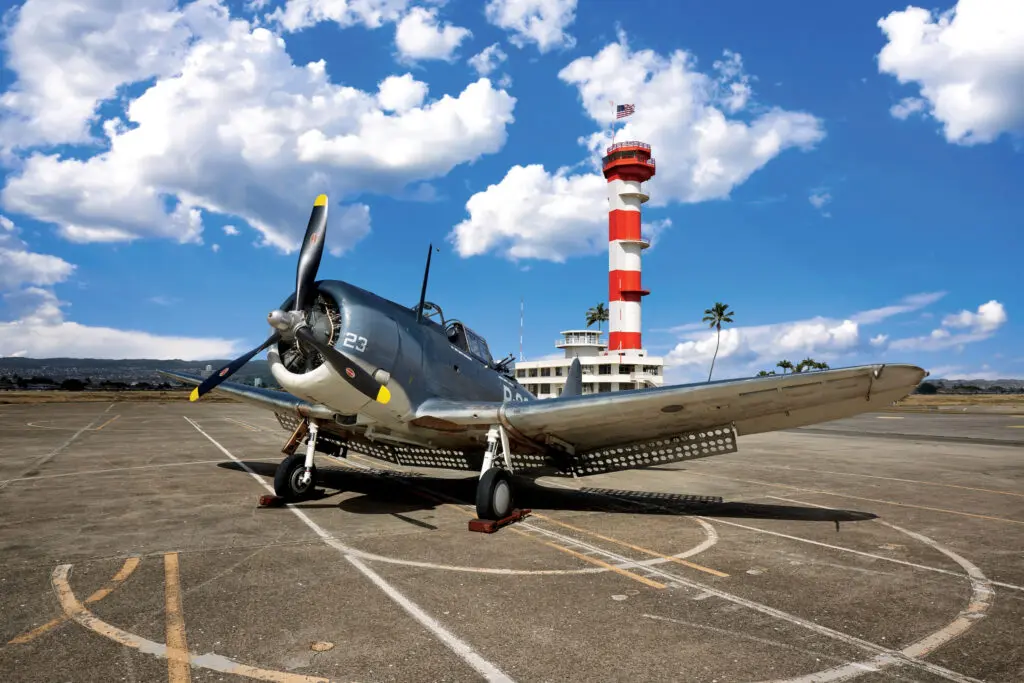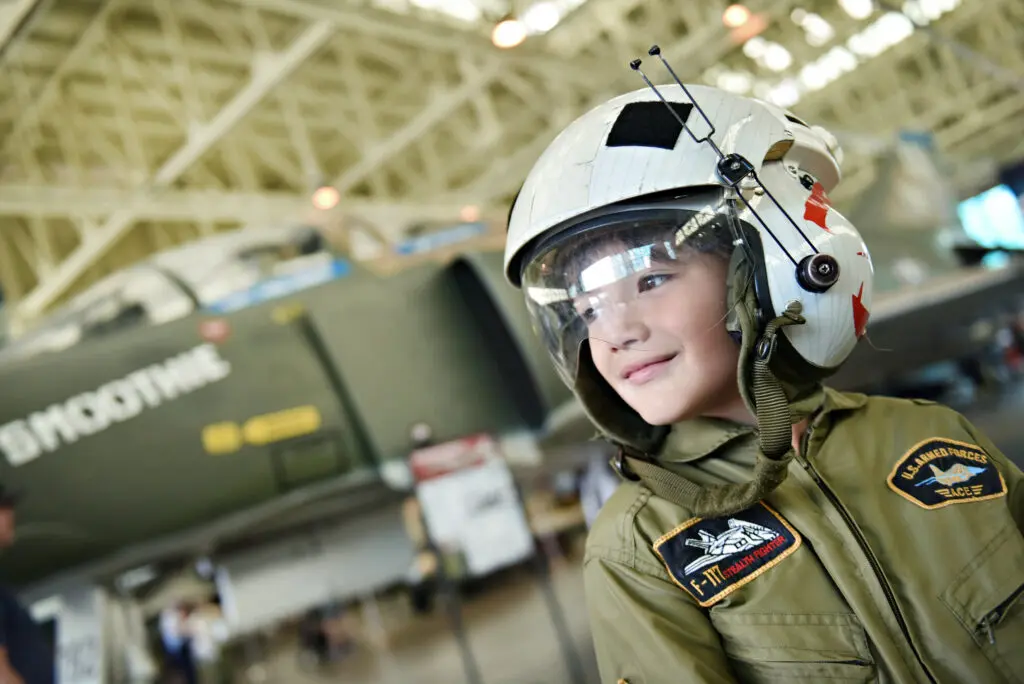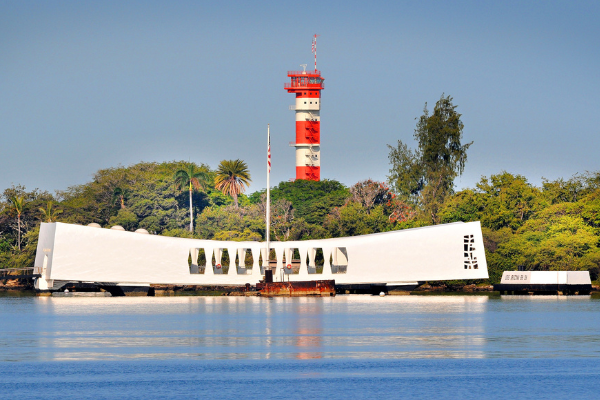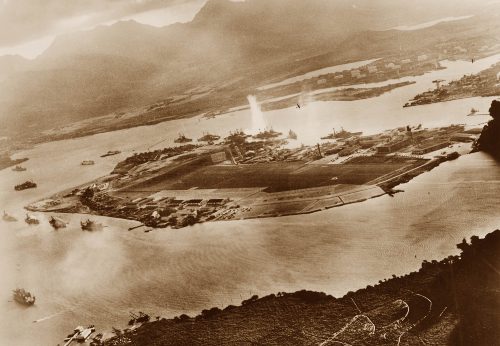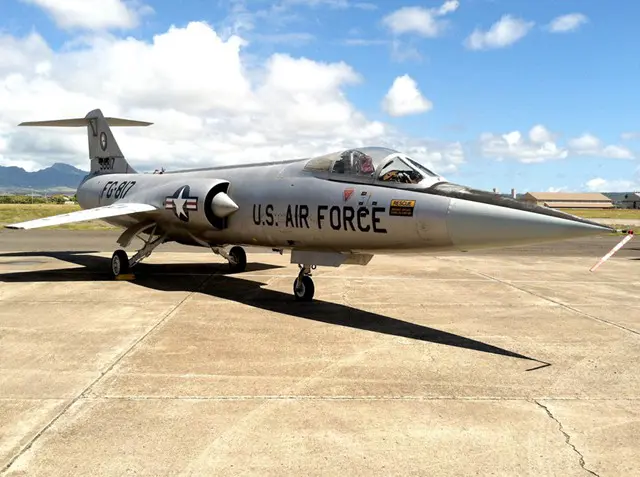Posted on May 15, 2013
By Ray Panko | [email protected] | Pearl Harbor Aviation Museum
The Zipper.
Designed as a day fighter, the Lockheed F-104 Starfighter was created by placing the most powerful available jet engine in the smallest possible fuselage. USAF pilots called it the Zipper or the Zip.

Source: United States Air Force
Key Points
It was the first aircraft to do sustained Mach 2 flight and the first to hold speed and altitude records simultaneously, as well as the first to reach 100,000 feet.
The Starfighter had a terrible safety record. It had tiny wings, a thin, heavy fuselage and a T-tail that created serious aerodynamic issues. In addition, early J79 engines were notoriously unreliable.
The USAF bought some F-104s for the Air Defense Command as stopgap interceptors until F-106s arrived. It also bought some F-104s as interim fighter-bombers until the F-105 was available.
The USAF only purchased 296 F-104s. The small fuselage limited internal fuel capacity and prevented it from having a powerful radar. When F-105s and F-106s arrived, only a year after the F-104 (which was itself delayed), the Zipper was assigned limited duty. Some served in Vietnam.
However, improved F-104s sold very well overseas in smaller nations, serving until 2004. Long range was not important in Europe, and the small nose cone could contain miniaturized radars. This overseas success was tainted when investigators found in 1975 Lockheed spent millions of dollars in bribes to sell aircraft to foreign customers.
NASA used Starfighters as chase planes, and it ordered three NF-104s as astronaut-training planes. With a rocket mounted in its tail, an NF-104 could zoom to over 100,000 feet and give the pilot up to 80 seconds of control practice turning the aircraft using nose and wingtip thrusters. Chuck Yeager famously flew to the edge of space in a NF-104 before the ship tumbled out of control and he had to bail out in the stratosphere. This incident is the central theme in the book “The Right Stuff.”
Prototypes and some F-104As had downward-firing ejection seats due to fear that upward-firing ejection seats could not clear the Starfighter’s high T-tail. However, the overwhelming majority of U.S. and foreign F-104s had traditional, upward-firing ejection seats.
A Small Rocket Ship
In Korea, frustrated Sabre pilots clamored for a day fighter that could fly higher and faster than Soviet MiGs. After visiting them in Korea, Clarence “Kelly” Johnson resolved to give them exactly that. He chose the most powerful engine he could find and built the smallest possible fuselage to hold it. The seat was tilted back 14 degrees, and pilots sat with legs extended. Johnson added vestigial wings, just big enough the get the fighter off the ground.
Figure 1: YF-104A and J79 Engine

Publicity shot of YF-104A and J79, http://commons.wikimedia.org/wiki/File:J79_with_F-104.jpg
The new Skunk Works-designed F-104 Starfighter was spectacular. In 1953, the North American F-100 Super Sabre prototype became the first airplane to achieve sustained supersonic flight. Less than a year later , the F-104 raised sustained supersonic flight speed to Mach 2.2. The Starfighter also climbed like a rocket and could reach the edge of space. It was the first aircraft to exceed 100,000 feet. It was also the first aircraft ever to hold speed and altitude records simultaneously, and grabbed climb-to-altitude records as well.
Reporters called it the “missile with a man in it.” Exhilarated pilots called it the Zipper or Zip. It also set a time-to-intercept record. It reached a target at 35,000 feet and 172 miles away in fewer than nine minutes.
Even today, few fighters can surpass its raw speed, climb rate, and ceiling. Kelly Johnson won the Collier Trophy for his design in 1955.

XF-104 with Lockheed Test Pilot Tony Le Vier (United States Air Force Photo)
Lockheed F-104G (S/N 63-13240) in flight. (U.S. Air Force photo)
The airplane was a fighter pilot’s aircraft. The cockpit was small, but comfortable. The tilted seat foreshadowed the F-16’s pilot position many years later. It had the best all-around vision of any U.S. fighter until the F-15 and F-16. Zipper pilot Robert Messerli described the experience of flying the F-104 as being like driving a car while sitting on the hood. He lauded the simple and well laid out instrument panel, which focused on firing weapons. He said that the aircraft was extremely stable as a weapons platform and when landing. He also praised the ranging radar for firing weapons.
Messerli also described taking off in a Zipper. As the engine was revved up, the aircraft shuddered and began to skid around even with the brakes fully on. It was like a dog straining on its leash. When the brakes were released, the aircraft shot forward instantly. If the pilot had not pointed it straight up the runway, it could easily run off the edge. Pull up took only 20 seconds from brake release. The plane rapidly reached .9 Mach and continued climbing. In one minute, it reached 20,000 feet. New pilots almost always overshot their level-off altitudes.
Acceleration continued to be astounding after the Zipper reached altitude. From Mach .9, it took less than three minutes to reach Mach 2. With this much acceleration, an F-104 pilot could decide when to engage in combat and when to leave. Coming at the rear of an enemy aircraft, it could rapidly pull within missile range before targets could react.
Technology
To reach Mach 2, the design team had ruthlessly eliminated drag. Wingspan was only 21 feet, and each wing extended only 7 and a half feet from the fuselage. The thin wing tapered from only 4 inches at the root to 2 inches at the wing tip. The front edge of the wing, with a radius of 0.00016 inch, was so sharp that the leading edge needed a protective cover when the jet was on the ground. On first seeing the prototype, Lockheed test pilot Tony Le Vier reportedly asked, “Where are the wings?”

Left: Ray Panko. Photographed at the Marsh Field Museum.
Right: National Museum of the Air Force 060928-F-1234S-005
These minimalist wings would not give the maneuverability a fighter would normally have. In addition, the small wings bled off speed rapidly in turns. However, the small wings were necessary to give Mach 2 performance. As test pilot Milton Thompson put it, the F-104 was designed “only to get to high altitude fast and pass the enemy at high-enough speed to avoid a dogfight and retaliatory missile. It was never intended to be a dogfighter; instead, it was a greyhound built to nip at the butt of the pit bulls as it passed by.”
In combat, the Zipper pilot would fly through the enemy formation, put on the brakes, turn the aircraft around, and point its nose at targets. It might do this several times. Its flight path represented lines and hooks. This might seem like an odd way to fight, but it fit the Starfighter perfectly.
To make landing speeds “reasonable,” The F-104 forced engine air through the wings to smooth the airflow and give more lift. With bleed air, the Zipper could land at the challenging but not extreme speed of 160 to 165 knots. If the air-bleed system was not working, landing speeds climbed to 240 knots.
To keep the horizontal tail out of the wing’s turbulence and air shadow, Johnson placed the stabilator (all-moving horizontal tail) at the top of the rudder. Many other aircraft followed this T-tail, including the Boeing 727 airliner. The all-moving stabilator’s bite was strong enough to turn the fighter at 5Gs at Mach 1.5. It gave optimum stability from take-off to Mach 2.
Unfortunately, a T-tail had a major disadvantage in supersonic aircraft. When traditional aircraft stalled, they tended to point their noses down. This improved recovery. However, supersonic aircraft with their thin heavy fuselages that have a pronounced effect on flight compared to the tiny wings, the nose tends to pitch up and tends to continue pitching up. In this deep stall, the horizontal stabilator atop the T-tail is in the shadow of the wings, making it useless when it is needed most.

Wikipedia, Flight (Stall). Deep_Stall.png by GRAHAMUK. GNU Public License
Problems in United States Air Force Service
The Starfighter was thrilling to fly, but dangerous. Referring to its diminutive wings, some joked that it had no visible means of support. The small thin wings were necessary to reduce drag enough for Mach 2 flight. However, the Zip’s thin body and small wings made it a poster child for the new phenomenon of inertial coupling, in which abrupt rotations on one axis could cause rapid rotations on another axis. However, these factors were overwhelmed initially by problems with General Electric J79 engines, which seemed to have a death wish. In just the first 100,000 hours of F-104 operation, 49 of the 296 Starfighters built for the United States Air Force crashed, killing 18 pilots. This was only the beginning of the death toll.
]In pursuing the USAF for sales, the Starfighter had a major problem. Lockheed optimized to be the perfect day fighter, but after Korea, the Air Force lost interest in day fighters. The Starfighter faced the prospect of being a total commercial failure. Fortunately, the Air Defense Command was concerned that the bisonic Consolidated F-106 Delta Dart interceptor was behind schedule. It ordered 153 F-104As as stopgap interceptors and 26 two-seat F-104Bs trainers. The ADC introduced Zippers in 1958 — two years later than planned — thanks to the Starfighter’s own development delays. To down enemy bombers, the F-104A had an M61A1 multibarrel cannon and a sidewinder missile on each wing tip or on underwing pylons.
The Zipper’s small size also caused serious problems in the intercept role. For bomber interceptions, the fuselage could not carry enough fuel for long-range interception missions. In fact, without external fuel tanks and refueling, which were impossible in an interception mission, the Starfighter’s range was a mere 300 miles. The F-104 could reach B-52s at 45,000 feet 150 miles away. However, for bombers flying on at 70,000 feet, the climb would use so much fuel that the Zipper would have to intercept the bomber directly over the airfield. In addition, the Starfighter’s nose cone was too small to carry an adequate long-distance intercept radar an interceptor needed, and Starfighter interceptors lacked the integration with the SAGE radar system that the F-106 would have when it was ready. Even with its limitations, however, the F-104 was usually the first aircraft called in a major crisis such as Quemoy, Berlin, and Cuba. It was sent to Vietnam despite the fact that the decision had already been made to retire in in favor of fighter interceptors with greater range.
In addition, the Tactical Air Command ordered 77 F-104Cs fighter-bombers and 21 F-104D trainers. This was again insurance, this time for the delayed Republic F-105 Thunderchief fighter-bomber, which the Air Force ordered to replace the barely supersonic F-100 Super Sabre.

Michael Wolf, 16 August 2007, GNU Public License, http://en.wikipedia.org/wiki/File:F-104_Waffenschacht.jpg.
Again, the Zipper’s small size causes serious problems. For the bombing role, the F-104C had to carry its bombs externally. It also needed to have external fuel tanks. With a special weapon (nuclear bomb) and external fuel tanks, the Zipper was not even supersonic. Even loaded with external fuel tanks, its combat radius was only 828 miles. The external refueling probe added to F-104Cs and Ds helped, but only somewhat.

Source: United States Air Force
A surprising thing that made the F-104 attractive as a low-altitude bomber was its tiny wings. At low level, its high wing loading meant that it did not bounce up and down with changes in wind and atmospheric density. It was remarkably stable at low altitudes and extremely high speeds.
The long-delayed F-106 finally arrived in 1959, only a year after its interim F-104A had entered service. The ADC quickly passed its F-104As and Bs to the Air National Guard but took them back during a series of crises in the early 1960s. It continued to use F-104As and Bs sparingly until 1969, when it passed them to the ANG for good. F-104Cs and Ds saw some combat in Vietnam until F-4 Phantom IIs replaced them. The Tactical Air Command sent its last F-104C to the ANG by 1968. In general, F-104 service was mostly a footnote in the histories of the Air Force and the Air National Guard, which flew their last Starfighters in 1975.

U.S. Air Force Lockheed F-104C Starfighters of the 475th Tactical Fighter Squadron at Da Nang Air Base, South
Vietnam, 1965. U.S. Government, public domain, http://en.wikipedia.org/wiki/File:F-104Cs_475TFS_DaNang_1965.jpg.

Source: United States Air Force
How Do You Say “Zipper” in German?
Having sold only 296 Starfighters to the Air Force, Lockheed was again staring at financial disaster. Amazingly, while the USAF was rejecting the Starfighter, the little pocket rocket found big markets overseas. European countries were worried because their Korean War Era F-84s and F-86s were inadequate against contemporary Eastern Bloc fighters. In 1958, in the “Deal of the Century,” West Germany decided to select a modern replacement. The United Kingdom proposed the BAC Lightning, while the French proposed the Mirage III. Several U.S. companies proposed their fighters and fighter-bombers, including the F-104, the F-105 and the Grumman Super Tiger.
West Germany decided to buy F-104Gs, where the “G” stood for Germany. With 1,127 examples, the G was by far the most numerous Starfighter variant. Although West Germany became the biggest user of Starfighters, other countries soon followed its example bought the Lockheed fighter. The list of buyers included Canada, Italy, Japan, Belgium, Denmark, Greece, Norway, Spain, Taiwan, Jordan, Pakistan, and Turkey. In most cases, these countries bought Starfighters from European consortia building F-104s under license. By the time production finally ended in 1983, 2,577 F-104s had been built. The overseas Starfighters also had a very long service life. West Germany used its Starfighters until 1986. Italy was the last operator. It flew its very advanced F-104S until 2004. In overseas service, the Starfighter continue to have serious losses; almost a third of the West German Starfighters were lost. The nickname widow maker was translated into German and several other languages. One common asked how you could get your own F-104. The answer was, “Buy a plot of land and wait for a Starfighter to crash on it.”

The European F-104Gs were much better than the USAF aircraft. The prototype, which first flew in 1960, was almost a complete redesign. The Zip’s small nose could now carry advanced radar for interception and bombing. The G used North American Aviation’s new North American Search and Ranging Radar (NASAAR) electronics suite. F-104Gs and later models had stronger fuselages to carry heavier loads and had larger vertical tail fins. Lockheed altered the slats so the aircraft could use them in combat, substantially shrinking the Starfighter’s turning circle. Although European Aircraft were heavier than the F-104Cs, they also had more powerful (and more reliable) J79 engines and retained their striking performance. In Europe, furthermore, the Starfighter’s limited range was not a deal breaker. Distances were small compared to those the continental United States and in Asia.
When Starfighters began selling spectacularly overseas, many observers were puzzled. Other aircraft seemed to offer better performance and better prices for the F-104’s roles. Eventually, investigators found that Lockheed had engaged in bribery on a massive scale to sell aircraft overseas. In 1975, Lockheed revealed that it had given millions of dollars in bribes. Investigators did not find specific links between bribery and specific F-104 sales, but bribery concerns forever tainted Starfighter’s overseas success.
NASA Zippers
Returning from F-104 overseas successes, there is one more chapter to the American F-104 story. Although the Air Force was disappointed in the airplane, NASA loved the Starfighter. As a chase plane for supersonic test aircraft, the Starfighter’s limited fuel capacity was irrelevant. It was exactly the fast high-flying hot rod that NASA needed in a chase plane. NASA used F-104s until 1994, when F-18s replaced the aging Zippers.
In addition, NASA purchased three NF-104As for astronaut training. NF-104As were heavily modified F-104As. To lighten the aircraft, all military equipment was removed. In addition, the tail fin was increased in size to give better control in the thin air of extremely high altitudes. Most importantly, the NF-104 had a rocket that could produce up to 6,000 pounds of thrust mounted at the base of its tail. This allowed the modified Starfighter to reach extremely high altitudes. In 1963, one of these hybrid aircraft set the world altitude record (for aircraft taking off from the ground) of 119,000 feet—slightly over 36 miles.

Edwards US Air Force Base Photo Gallery, http://en.wikipedia.org/wiki/File:NF-104.jpg.
In this airless environment, the pilot controlled the modified aircraft with thrusters at the aircraft’s nose, tail, and wing tip. The aircraft could spend enough time beyond thicker air to allow a useful period of thruster-control practice, which would be used on spaceships.

In December 1963, General Chuck Yeager, who was in command of the astronaut training school, took one of the NF-104As to an altitude of 108,000 feet. Unfortunately, neither his aerodynamic or thruster controls would pitch is nose down. After fourteen spins, the aircraft hit the ground. Yeager ejected on the thirteenth, but his ejection seat tumbled and pushed him out while it was above him. It dropped faster than he did, and it hit him. Slag from the seat’s rocket motor burned his face and hands. This story was portrayed in the movie The Right Stuff.

Chuck Yeager in the cockpit of an NF-104, December 4, 1963. (U.S. Air Force photo).
http://en.wikipedia.org/wiki/File:Chuck_Yeager_in_NF-104.jpg.
Finally, About the Ejection Seats
The Starfighter’s high T-tail was necessary for aerodynamic reasons. However, pilots ejecting at Mach 1.8 would hit the tall fin and stabilator. Consequently, ejection seats in the prototypes ejected downward. Although this worked, it would be fatal at lower altitudes, especially during takeoff and landing. This downward-firing ejection seat is one of the most notorious aspects of the F-104 design. However, downward-firing ejection seats were only used in prototypes and early-production F-104As. All later USAF aircraft used the upward-firing Lockheed C-2 ejection seat. Foreign operators typically used the superior upward-firing Martin-Baker GQ-7 ejection seat.
Although the number of Starfighters with downward-firing ejection seats was not great, 21 pilots died ejecting downward from F-104s. One was Iven Kincheloe, who was a test pilot for the X-2 and X-15. While flying a chase F-104 at 2,000 feet, his engine flamed out. Ejecting downward would have been suicide, so rolled the aircraft in order to eject toward the sky, but crashed into the desert floor before he could complete the roll. The last downward ejection from an F-104 occurred in 1959, when chase plane pilot Norvin Evans lost oil pressure and successfully ejected.
Perspective
In the end, the F-104 Starfighter had a checkered career marred by numerous crashes, poor performance in USAF roles and the taint of overseas bribery. Yet Kelly Johnson’s hot rod continues to quicken the pulse of everyone who sees one of these aircraft, even when it is just sitting on the ground. Many feel that its raw speed, climb, altitude, and looks made it the most exciting fighter ever built.

Our F-104A
Our F-104A (56-817) was ordered in 1956 and delivered to the Air Force in July 1958. It first served the 538th Fighter Interceptor Squadron at Larson Base, Washington. It also served at Taichung Air Force Base in Taiwan. In 1963, it was transferred to the Air Force Flight Test Center at Edwards Air Force Base in California. There, it served as a support aircraft (chase plane). It was retired in 1972. In 1987, it moved to the Museum of Aviation at Robins Air Force Base in Warner Robins, Georgia. In May 2013, it arrived at its new home, Pearl Harbor Aviation Museum.

Pearl Harbor Aviation Museum, Flickr Stream
By the way, she had a bit part in the television show “I Dream of Jeannie.” The major flew F-104s, and in most episodes, there is a picture of an F-104 landing, then a cut to Major Anthony Nelson (Larry Hagman) climbing out of a cockpit. The landing Starfighter was our 817.

References
Bowman, Margin. (2004). The Pocket Book of Fighters: The Definitive Guide to the Fighters of the World, New York: Barnes & Noble Books.
Chant, Christopher and Taylor, Michael J. H. (2005). The World’s Greatest Aircraft, Edison, New Jersey: Chartwell Books,
Crosby, Francis. (2002). A Handbook of Fighter Aircraft, London: Hermes House
Evans, Norvin C. (2010, March). “Above and Beyond: The Unhappy Bottom Riding Club,” Air and Space Magazine.
Globalsecurity.org, “F-104 Starfighter,” www.globalsecurity.org/military/systems/aircraft/f-104-specs.htm.
Marrett, George J. (2002, November). “Sky High,” Air and Space Magazine.
Merlin, Peter and Vetter, Scott. (2013, January 12 update). “NASA Research Aircraft,” International F104 Society “Zipper” Magazine, N. 46.
Messerli, Robert E. (2005), “Slipping the Surly Bounds with a Zip—The F-104,” pp. 107-119 in Robin Higman (Ed.), Flying American Combat Aircraft: The Cold War, Mechanicsburg, Pennsylvania: Stackpole Book.
Paloque, Gerard. (2000). F-104 Lockheed Starfighter: 1958-2000, Paris: Historie & Collections.
Sampson, Anthony. (1976, March 15). “Lockheed’s Foreign Policy: Who, in the End, Corrupted Whom?” New York Magazine, 9(11), pp. 53-56, 58-59.
Sharpe, Michael. (1994). Attack and Interceptor Jets, New York: Barnes & Noble Books.
Wikipedia, “Stall (Flight).” http://en.wikipedia.org/wiki/Stall_(Flight)
Wilkinson, Stephen. (2010, September). “Be Quick, Be Quiet, and Be On Time,” Aviation History, 21(1), pp. 25-31.
Williams, Ted and Williams, Amy E. (2002). The American Fighter Plane, New York: Metro Books.
Windle, Dave and Bowman, Martin. (2012). Profiles of Flight: Lockheed F-104 Starfighter: Interceptor, Strike, and Reconnaissance Versions, Barnsley, South Yorkshire, UK: Pen & Sword Aviation.
Yeager, Chuck. (1986). Yeager: An Autobiography, New York: Bantam.
